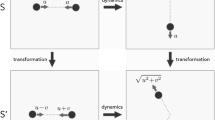Abstract
The usual macroscopic theory of relativistic mechanics and electromagnetism is formulated so that all assumptions but one are consistent with both special relativity and Newtonian mechanics, the distinguishing assumption being that to any energyE, whatever its form, there corresponds an inertial massE/c 2. The speed of light enters this formulation only as a consequence of the inertial equivalent of energy1/c 2. While, for1/c 2>0 the resulting theory has symmetry under the Poincaré group, including Lorentz transformations, all its physical consequences can be derived and tested in any one inertial frame. In particular, an account is given in one inertial frame for the dynamic causes of relativistic effects for simple accelerated clocks and roads.
Similar content being viewed by others
References
Physics Today 27 (January), 112 (1974).
J. C. Maxwell,Treatise on Electricity and Magnetism (Clarendon Press, Oxford, 1873), Vol. 2, p. 391.
P. Lebedeff,Archives des Sciences Phys. et Nat. 8, 184 (1899).
J. J. Thompson,Phil. Mag. 11, 229 (1881).
O. Heaviside,Phil. Mag. 27, 324 (1889).
E. Fermi,Lincei Rend. 31, 184, 306 (1922).
H. Poincaré,Arch. Néerland Sci. 2, 232 (1900).
A. Einstein,Ann. Physik 18, 639 (1905).
H. E. Ives,J. Opt. Soc. Am. 42, 540 (1952).
W. Kaufmann,Nachr. Akad. Wiss., Göttingen, II Math. Phys. Kl.1901, 143.
G. N. Lewis,Phil. Mag. 16, 705 (1908).
M. Planck,Verhandl. Deut. Physik. Ges. 10, 728 (1908).
H. A. Lorentz,Versl. Gewone Vergad. Akad. Amst. 20, 87 (1911).
E. Inönü and E. P. Wigner,Proc. Nat. Acad. Sci., U.S. 39, 510 (1953).
P. Havas,Rev. Mod. Phys. 36, 938 (1964).
E. P. Wigner,Symmetries and Reflections (Indiana Univ. Press, Bloomington, 1967), p. 16.
L. Jánossy,Usp. Fiz. Nauk 62, 149 (1957).
M. Le Bellac and J.-M. Lévy-Leblond,Nuovo Cimento 14B, 217 (1973).
Author information
Authors and Affiliations
Rights and permissions
About this article
Cite this article
Davidon, W.C. Consequences of the inertial equivalence of energy. Found Phys 5, 525–542 (1975). https://doi.org/10.1007/BF00708894
Received:
Issue Date:
DOI: https://doi.org/10.1007/BF00708894




